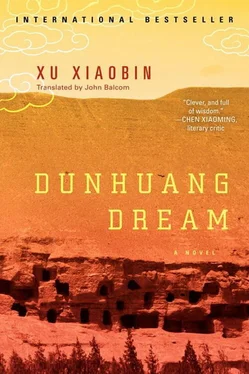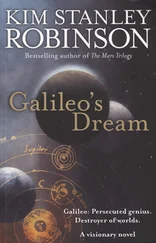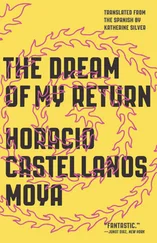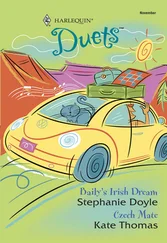That evening, Xingxing climbed to the highest part of the easel and began painting with a special sketching brush. Standing below her, Old Lu kept reminding her, “It’s best to pause while doing the floating belts of the flying apsaras and the draped robes of the bodhisattvas. They can’t be done in a single stroke. Take a look at this Tang dynasty fresco — the fingernails of the human figures must be set deeply in flesh. It’s best to apply the brush in a circular motion. The liniments must flow. Do you know how they painted the folds in clothing during the Tang dynasty?”
“Naturally with an orchid-leaf stroke,” replied Xingxing, without turning her head.
“Right.” Old Lu nodded. “Let me test you on another one: what sort of outlining was used in frescoes during the Sixteen Nations period?”
“Wire outlining was used on most of the early frescoes,” said Xingxing, turning around this time. During the period of the Sixteen Nations, human figures were slim and the folds in their gowns numerous, so naturally wire outlining was used; human figures of the Tang dynasty tended to be fleshy, the lines dense and lively, so the orchid stroke was used; brushwork in the Yuan dynasty was much richer — human figures were traced using wire outlining whereas the folds in clothing were done using a gourd-pouring stroke; beards, eyebrows, and sideburns hair were done with a flowing silk stroke. . Am I right?”
“Right, right,” said Old Lu, nodding rapidly, his eyes filled with delight. “I never imagined such a young woman would know so much about fresco paintings in Dunhuang.”
Tang Renxia laughed loudly. “Comrade Xingxing once restored paintings. Old Lu, save your questions for our Weiwei. Do you think you can catch Xingxing, that she doesn’t know her stuff?”
“Such talent is hard to come by. So you restored paintings,” commented Old Guan, who had been silent the whole time. “Perfect. We are having some problems in copying some aspects of the paintings to make them look old. Perhaps you can help.”
“Have you used methods such as cutting with a knife, rubbing with mud, brushing with the hand, or affixing paper to make them look old?” said Xingxing as she painted the long, flowing sleeves of an apsara.
“We’ve tried all those methods, but they did not achieve the desired effect,” commented Tang Renxia. “There are plenty of ideas. . but we have to spend a lot of time trying them out. A French group is coming, and the higher authorities want us to finish this painting before they arrive. That’s not much time, is it? It’s wonderful that you can help out.”
16
Xingxing slowly sank into her world of color.
Old Lu and Old Guan were accustomed to working through the night without sleeping, but on this particular night they felt very tired. Their fatigue was a result of Xingxing’s presence. Despite Director Tang’s glowing recommendation and Xingxing’s outstanding show, the two old men didn’t have much confidence in her. They were among the best fresco copyists in the country, and they were deeply attached to the frescoes at Dunhuang and were conscientious and meticulous in their work.
Xingxing swung her legs from the scaffolding without making a brushstroke for some time. The frescoes at Dunhuang never ceased to amaze her. Those of the Sixteen Nations were unaffected and straightforward; those of the western Wei and Northern Zhou, lovely and refreshing; those of Sui and Tang, resplendent and magnificent; those of the Song and the beginning of the Five dynasties, brightly colored; those of the western Xia, cool and refined; and those of the Yuan, simple and elegant. The use of color in the early frescoes was free and unrestrained and very lively; after the Tang dynasty, the first sketch was very accurate and precise; the color was applied by filling in, or even neatly scraping between the lines and in some cases a narrow white line was left between the colors and the black outline. Such details were a headache for the copyists.
Xingxing began to apply the final hue, but getting the color just right was very difficult, especially on a painting of such scale. Standing beside her, Old Lu mentioned that in some copies, they had got the hue wrong and the entire painting ended up looking much older and dimmer than the original. It seemed that the artisans of old had used the brightest primary pigments undiluted.
Painting was very absorbing. But Xingxing just couldn’t calm her mind today. That scene in her room would assert itself like a montage in her mind’s eye. She knew that nothing had happened and that nothing would happen, but she just couldn’t stand that whole scene. She couldn’t fool herself again. The only possible reason being that she had fallen in love with Wuye, a young man eleven years younger than herself.
She made up her mind to leave, to leave before the copy of The Transformation of the Western Paradise was complete. She would do it for him and for herself, for all good times must come to an end.
If one is doomed in life to be parted from those one loves, then it would be best to leave, and leave early, that way some beautiful memories would be preserved.
Would she have been happy if she and Xiaojun had married back then? She had her doubts now.
The wind whipped up that night. It was a cold, piercing wind to her. She became a small solitary leaf in the wind, blown through a world of green, blue, red, and white. Falling slowly to the ground these colors coalesced to form a blood red. She herself was dyed the same color, a blood-red leaf, just like the maple leaf that her sister gave to her when she was thirteen. Later the maple leaf dried up and turned a scabby brown. .
Later, after it happened, Old Lu and Old Guan recalled that it was early in the morning and they wanted to get a little more shut-eye when they vaguely heard a voice say, “Just like a fallen leaf.” Those were the very words. That’s when they saw Xingxing lying on the ground, her back toward them, her black hair soaked with blood.
17
It had been a while since Chen Qing had told a story. That night, the night Xingxing fell from the scaffold, he told the story of the Lotus Girl.
Legend had it that in ancient times there was a big mountain at Dunhuang on which lived two Daoist priests. The one who lived on the south side of the mountain was called the Daoist Priest of the Southern Grotto, and the one who lived on the north side was called the Daoist Priest of the Northern Grotto. One summer the Daoist Priest of the Southern Grotto went to bathe in the spring at the foot of the mountain where he encountered a doe giving birth, but strangely, she did not foal a deer but rather a beautiful baby girl. Seeing a stranger, the deer fled. The Daoist Priest of the Southern Grotto quickly picked up the infant girl and took her home and raised her as if she were his own daughter. Time passed quickly and the deer girl grew into a lovely young woman. One day the fire went out and the Daoist Priest of the Southern Grotto told the girl to get some embers from the Daoist Priest of the Northern Grotto. The deer girl headed north, but strangely, with every step she took a lotus blossom sprouted, the fragrance of which wafted into the Northern Grotto. Smelling the fragrance, the Daoist Priest of the Northern Grotto came out and was transfixed. The deer girl bowed to him and said, “Please, sir, I have come for some coals.” The Daoist priest of the Northern Grotto replied with a smile at once, “No problem, all you need to do is circle the Northern Grotto forty-nine times.” So that’s what the deer girl did. With each step a lotus sprouted and the grotto was filled with the blossoms, the fragrance all-enveloping. After that, everyone called the deer girl Lotus Girl. . and that’s where the expression “lotus blossom sprouting at every step” comes from.
Читать дальше







![Theresa Cheung - The Dream Dictionary from A to Z [Revised edition] - The Ultimate A–Z to Interpret the Secrets of Your Dreams](/books/692092/theresa-cheung-the-dream-dictionary-from-a-to-z-r-thumb.webp)




